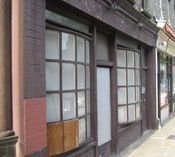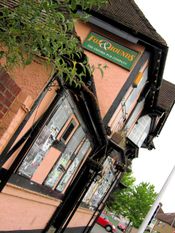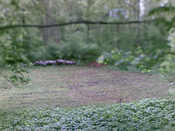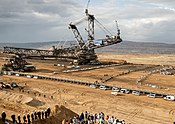Ko:Lifecycle prefix

실수로 다시 매핑할 가능성이 크거나 상태가 바뀌고 있거나 논란의 여지가 있는 경우에만 현재 있는 지물이 아닌 지물 혹은 상태를 매핑할 수 있습니다.
보기를 들어, 철거된 건물이 항공 이미지에 보인다면
demolished:building=* 태그를 붙여서 실제로는 철거되었다는 것을 밝히는 것이 더 낫습니다. 혹은 확정된 계획도 반영할 수 있습니다.| 이 쪽은 단순한 태그가 아니라 이름요소를 설명하고 있습니다. |
수명주기/상태 이름요소 머릿말(prefix)은 제안됨(proposed), 계획됨(planned), 공사 중(construction), 사용 중지(disused), 버려짐(abandoned), 철거됨(demolished), 역사(historic) 지물과 같이 지물의 상태를 태그하는 데에 쓸 수 있습니다. 아울러 수명주기 개념 비교 문서를 참고하십시오.
By using this key prefix it is ensured that current or legacy applications are not confused by objects which do not exist or are not fully functional and only software aware of this tagging concept will evaluate those.
See also date namespace for a related proposal to include dates for historic tags, for example name:-1965=Kings Place. The two possibilities can be combined to some extent.
No longer existing objects may be marked as existing in other sources. For example demolished building may be visible on aerial images, official maps may include now dried up wetland etc. Using lifecycle prefixes it is possible to clearly mark that specific object must not be remapped without proper verification. Once there is no real risk of remapping them by person thinking that this objects are still existing such elements should be deleted from OSM.
지물의 현재 상태와 관련이 없는 과거 지물은 일반적으로 오픈스트리트맵에 넣지 않습니다.
역사 데이터는 Open Historical Map에서 덧보탤 수 있습니다.
태그 방법
Add a namespace prefix (for example disused:*=*) to all keys which are no longer relevant to the current state of an object. You should treat all the tags on an object as a set of facts about the object, and prefix the keys of those facts which are no longer true as a result of the disuse. For example, a concrete parking area which is no longer used for parking cars but which still carries a name sign might be tagged as
which makes it unavailable to programs which search parking, and unlikely to be displayed as parking in any default rendering. The name is still relevant, and will still be searchable. If the area is opened up again, it's a simple matter to undo the prefixing.
일반적 머릿말
만들어 지는 단계
proposed:*=*- Planned, with a high likelihood of being constructed
- See also scheme
proposed=*in combination withhighway=proposed,railway=proposed,aeroway=proposed, etc. - usage: ~38,400 elements (nodes, ways and relations) include the prefix (as of 2021-04)
planned:*=*- Planned, with a high likelihood of being constructed (possible duplicate of
proposed:*=*) - Some consider
planned:*=*to be stricter thanproposed:*=*(i.e., a planned feature that is approved and funded). - usage: ~2,900 (as of 2021-04)
construction:*=*- Being constructed at this time (or construction work for maintenance or modification is performed)
- See also scheme
construction=*in combination withbuilding=construction,highway=construction,landuse=construction,railway=construction, etc. - usage: ~42,100 (as of 2021-04)
없어지는 단계
disused:*=*- Not currently in use, but could be reinstated easily
- For physically prominent objects (e.g. buildings, towers or quarries),
disused=yesis used more often[1]. - Railways:
railway=disusedis still used in addition to the lifecycle prefix, as it pre-dates the introduction of prefixes.[2] - usage: ~177,600 (as of 2021-04)
abandoned:*=*- Still visible but fallen into serious disrepair and which could only be put back into operation with considerable effort
- For physical objects (e.g. buildings, towers or quarries),
abandoned=yesis used more often[3]. - Railways:
railway=abandonedfor partially dismantled tracks is still used in addition to the lifecycle prefix, which pre-dates prefix introduction.[2] - usage: ~277,900 (as of 2021-04)
ruins:*=*- Only ruins are remaining
- usage: ~3,400 (as of 2021-04)
The following four tags are available to reduce the possibility of a mapper remapping the feature from existing available sources used to edit OSM, e.g. satellite or aerial imagery, that shows the old state of the feature. Once the OSM available sources do not show the feature, the feature can safely be removed from OSM. Renderers cannot rely on OSM preserving physically vanished history.
demolished:*=*- Not existing anymore because of active removal
- May have been used for features that are almost but not completely invisible
- usage: ~41,100 (as of 2021-04)
removed:*=*- Not existing anymore because of active removal (possible duplicate of
demolished:*=*) - usage: ~27,600 (as of 2021-04)
razed:*=*- Not existing anymore because of active removal (duplicate of
removed:*=*, possible duplicate ofdemolished:*=*) - Railways:
railway=razedfor fully dismantled tracks and trackbed (overbuilt state) is still used in addition to the lifecycle prefix, because it pre-dates prefix introduction.[2] - usage: ~25,900 (as of 2021-04)
destroyed:*=*- Destroyed by an event other than intentional demolition
- usage: ~5,300 (as of 2021-04)
쓰임새 바뀜
was:*=*- Not what it used to be
- usage: ~47,300 (as of 2021-04)
- For shops or businesses, disused:* and was:* tags are identical, it is mostly a matter of personal preference and both will achieve the same result, i.e. the place will no longer appear on the map while the information would be easily visible to anyone editing the map, preventing the accidental re-addition of those tags.
덜 일반적 머릿말
Stages of decay
closed:*=*- Not currently in use, but could be reinstated easily (duplicate of
disused:*=*) - Used for closed businesses and services (e.g. shops, restaurants, offices, banks).
- usage: ~600 (as of 2021-04)
no:*=*- Does not currently exist.
- usage: ~760 (as of 2023-03)
Repurpose
historic:*=*- Misleading because of inconsistent use – not recommended for lifecycle tagging
- While someone tried to establish the concept of "a previously valid characteristic for an object that has different properties today", this never actually got accepted and this prefix is used for various other things in an inconsistent manner. Most used as
historic:civilization=*,historic:period=*,historic:railway=*andhistoric:<some railway property>, further ashistoric:year:*(similar to the date namespace) and some other ways. - usage: 92,700 (as of 2021-04)
그 밖에
emergency:*=*- Used on multi-purpose facilities to reflect a temporary, secondary function for exigencies
- usage: ~15,900 (as of 2021-04)
not:*=*- Used for prevention of confusion
보기
| Image | Tagging | Description |
|---|---|---|

|
disused:shop=yes
|
A closed-down shop of some sort. If the type of shop it used to be is known, substitute the appropriate value from shop=* for yes.
|

|
disused:amenity=pubdisused:operator=The Oxford Pub Companyname=Fox & Hounds
|
Boarded-up disused public house. It no longer has an operator as such - no beer is sold - but the name is still useful for navigation. |

|
railway=disuseddisused:railway=rail
|
Historic railway line. Tracks not degraded but overgrown. |

|
electrified=noconstruction:electrified=contact_line
|
Railway line with electrification works in progress. |

|
disused:leisure=pitch
|
Disused pitch, now somewhat overgrown. |

|
objects that were there before open pit mine are not tagged | Open pit mine. Forest that used to be here must not be tagged in any way, as no identifiable trace of it remains and is unlikely to be mistakenly mapped again. Only in cases where mappers are likely to reintroduce old objects (pit mine is new and not visible in some still used aerial images) it can be mapped. |

|
railway is not tagged | Place where railway existed in the past. It must not be tagged in any way, as no identifiable trace of it remains and is unlikely to be mistakenly mapped again. Only in cases where mappers are likely to reintroduce old objects (railway was dismantled recently and is still visible in some used aerial images) it can be mapped. |

|
canal/moat is not tagged | Place where waterway existed in the past. It must not be tagged in any way, as no identifiable trace of it remains and is unlikely to be mistakenly mapped again. Only in cases where mappers are likely to reintroduce old objects it can be mapped (recent removal, and likely to remapped from aerial image). This specific viaduct was constructed in 1863 as a bridge over canal that was filled in 15 years later. |
함께 보기
disused=*– commonly used for man-made features and buildings which still appear normal but which are not being used.abandoned=*– commonly used for man-made features which have been abandoned but are still visible as that feature.proposed=*– The proposed tag may be used for any road, railway or route that is in planning phase. In combination withhighway=proposed,railway=proposed,aeroway=proposed, etc.intermittent=*– Used to indicate whether or not a waterway or water body does not permanently contain waterconstruction=*– This key is used together with the higher-level tags building/highway/railway/landuse=construction to describe the type of the feature which is currently under construction. Required combination withbuilding=construction,highway=construction,landuse=construction,railway=construction, etc.start_date=*– date on which a feature opened or construction of the feature finishedconstruction_date=*- date on which construction of the feature has been finishedopening_date=*– date on which a feature is expected to be openedend_date=*– date on which a feature is planned to go out of use, or when it went out of service- Proposed features/temporary
- Proposed features/temporary (conditional)
- Demolished Railway – tagging of demolished railways
- Open Historical Map
각주
- ↑ see for example quarries: disused:landuse=quarry is used 706 times while 4627 landuse=quarry have disused=yes
- ↑ 2.0 2.1 2.2 Using
railway=disused;abandoned;razedheterogenified the value set of key railway by mixing track class with lifecycle class values. With this legacy lifecycle representation the track class information usually expressed inrailway=*is lost (practical consequence e.g.: a data user cannot differentiate between abandoned tram or rail tracks). As a long-term change it is recommended to support and evaluate the lifecycle prefix variants. The presence of both tagging variants on data objects is still advocated by wiki, but this may change in the future. - ↑ see for example quarries: abandoned:landuse=quarry is used 669 times while 2364 landuse=quarry have abandoned=yes